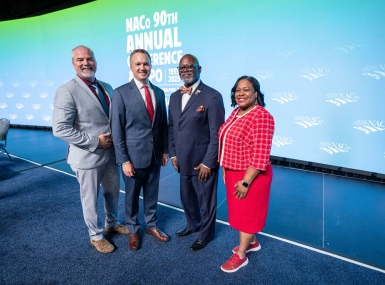2014 county population: growth remains stable
 Population growth is an im portant component of regional economic vitality. Understanding population trends h elps county-elected and other stakeholders to plan services for their residents and help local businesses. The U.S. Census 2014 county population data released last month are key tools for county leaders to use toward that end.
Population growth is an im portant component of regional economic vitality. Understanding population trends h elps county-elected and other stakeholders to plan services for their residents and help local businesses. The U.S. Census 2014 county population data released last month are key tools for county leaders to use toward that end.
Overall, county populations exhibited continuity in their growth patterns. Half of the 3,069 counties experienced population growth from 2013 to 2014 (See the counties marked in blue on Map 1). The largest U.S. coun ties those with populations over 500,000 grew most consistently, with 92 percent of the 126 large counties adding population. Sonoma County, Calif. and Montgomery County, Texas passed the 500,000 residents threshold last year.
Seventy percent of mid-sized counties with populations between 50,000 and 500,000 added residents, as did 40 percent of the smallest ones, those with fewer than 50,000 people. Kerr County, Texas and Lincoln County, S.D. grew beyond 50,000 residents in 2014.
Population expansion in about a fifth of counties outpaced the U.S. average in 2014. The majority of these high-growth counties are located in the South, mostly mid-sized, with populations between 50,000 and 500,000 people. Texas alone has more than 100 such high-growth counties. Harris County, Texas holds the top spot in terms of the number of new residents added in 2014 almost 90,000. But one North Dakota county remains the fastest growing county in the country; McKenzie County, N.D.'s population ex panded at more than 18 percent between 2013 and 2014 (See Map 2). Oil production in McKenzie County, located on the Bakken Formation, reached 11.8 million barrels in January 2015, the most of any county in North Dakota.

Regional and state differences are also apparent. Similar to 2013, western and southern counties were most likely to experience population growth. Sixty percent of western counties and 53 percent of southern counties expanded in terms of population. North eastern and midwestern counties lagged, with only 42 percent and 39 percent of them adding residents last year. Several small states Hawaii, Delaware and Massachusetts saw all of their counties add population between 2013 and 2014.
Among larger states, Washing ton, Florida, California, Arizona, Idaho and Oregon had more than 70 percent of their counties grow. More counties in Idaho, Maine, New Hampshire and Washington added population in 2014 than in the previous year.
These findings highlight some of the county population trends from 2014. The demands on county officials and governments to provide essential services only increase as counties grow.
Attachments
Related News

J.D. Clark takes office as NACo president
J.D. Clark stressed the importance of telling the county story as he took office as NACo president.

Former FEMA chief is bearish on reform talks
Former FEMA Administrator Brock Long has yet to hear any proposals for federal disaster reform that would make a significant improvement to the way it operates.

Casey Foundation emphasizes support for youth
“When youth are asked what helped them the most, they might name a program, but they will absolutely name a person that believed in them,” Leslie Boissiere told the General Session audience.
